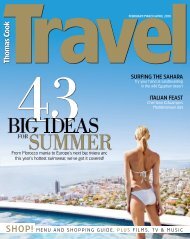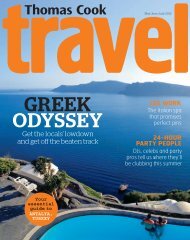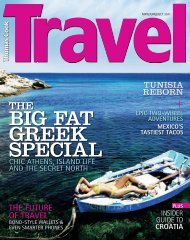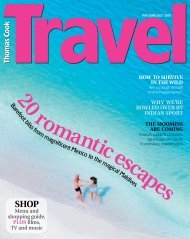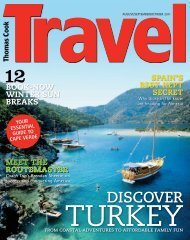november-2011
november-2011
november-2011
Create successful ePaper yourself
Turn your PDF publications into a flip-book with our unique Google optimized e-Paper software.
THOMAS COOK WELLBEING<br />
Electronic<br />
equipment<br />
Technology moves at<br />
such a fast pace that<br />
you may be confused<br />
about what electronic<br />
equipment you can and<br />
can’t use onboard. To<br />
help you, we have the<br />
following guidelines.<br />
The use of radios is strictly prohibited.<br />
Mobile telephones, with the exception of<br />
those with a “flight safe” mode, should be<br />
switched off at all times on board the<br />
aircraft. Phones with a “flight safe” mode<br />
should have this activated before you<br />
switch your phone off for take off.<br />
Personal CD, DVD, MP3 and MiniDisc<br />
players may be used, but only when the<br />
seatbelt sign is switched off.<br />
Wireless devices such as PDAs, laptop<br />
computers, electronic games and E-readers,<br />
may only be used onboard if the wireless<br />
function is disabled and again, may only be<br />
used while the seatbelt sign is off.<br />
Simple as ABC<br />
To feel your best in<br />
the air, remember:<br />
Alcohol<br />
Alcohol should be consumed only in<br />
moderation. For each glass of alcohol, drink<br />
two glasses of water. Try to drink at least a<br />
pint of water every three hours.<br />
Baggy<br />
Baggy clothes are best in the air. Try not<br />
to wear any tight-fitting clothing, loosen<br />
top buttons, belts and shoelaces and<br />
remove tight socks. We do, however, ask<br />
that your dress remains respectable<br />
throughout the flight.<br />
Circulation<br />
Circulation of blood is helped if you try<br />
not to cross your legs or ankles for long<br />
periods of time. Elastic support socks<br />
or stockings may help, but they must be<br />
measured by your doctor or pharmacist. Our<br />
recommended exercises will also help blood<br />
circulation, but if you feel any discomfort<br />
when performing them, then please stop.<br />
108 Thomas Cook Travel<br />
Inflight exercise<br />
Humans aren’t designed to sit in one position<br />
for long, so to promote blood circulation<br />
we recommend the following exercises. Try<br />
them while seated and remember that even the<br />
smallest movements help with blood circulation.<br />
UPPER BODY<br />
1 Take a large breath in through the<br />
nose. Slowly exhale through the mouth.<br />
Repeat a maximum of four times.<br />
2 Sitting upright, turn your head<br />
slowly to look over one shoulder. Now<br />
slowly turn to the other side. Repeat<br />
five times.<br />
LOWER BODY<br />
1 Loosen or remove your footwear. Arch<br />
the soles of both feet and curl your<br />
toes 10 times.<br />
2 Straighten your legs, slightly lift<br />
your feet off the floor and pump both<br />
ankles forwards and backwards about<br />
20 times.<br />
3 Tense and relax your thigh muscles<br />
about 10 times.<br />
4 March your feet on the spot 10 times,<br />
alternating between the heel and the<br />
ball of your foot.<br />
3 Slowly rotate your shoulders<br />
backwards. Repeat this exercise<br />
five times.<br />
4 Raise one arm above your head and<br />
stretch upwards. Repeat with the<br />
other arm.<br />
5 Transfer your weight evenly between<br />
each buttock.<br />
5 Clench your buttock muscles together<br />
10 times.<br />
6 If queuing for the toilet, try<br />
rocking backwards and forwards, heel to<br />
toe and back.<br />
7 Upon landing, gently stretch your<br />
body to get ready for movement.<br />
8 If you are travelling on a long-haul<br />
flight, try to move around the cabin<br />
every couple of hours.






